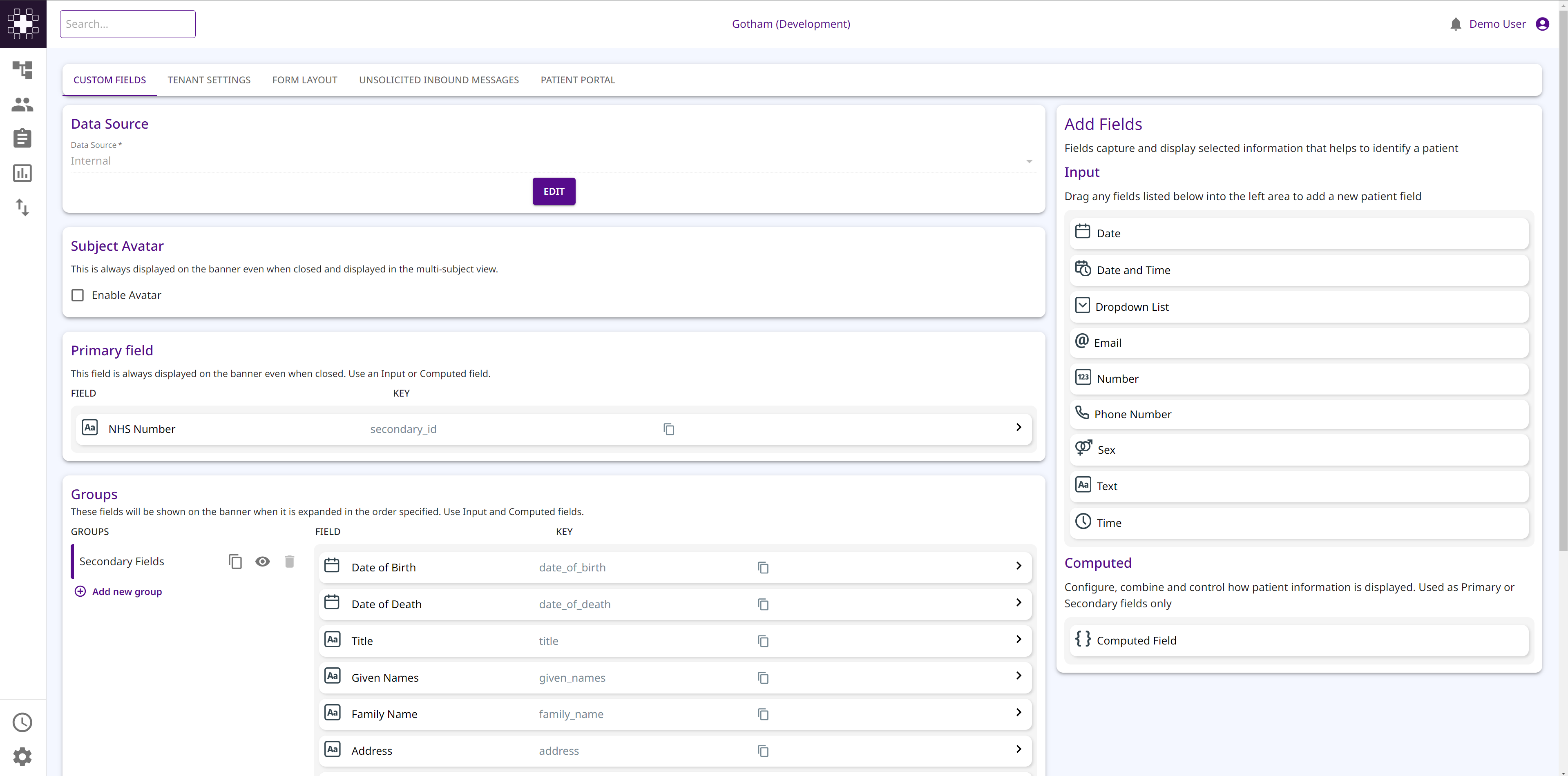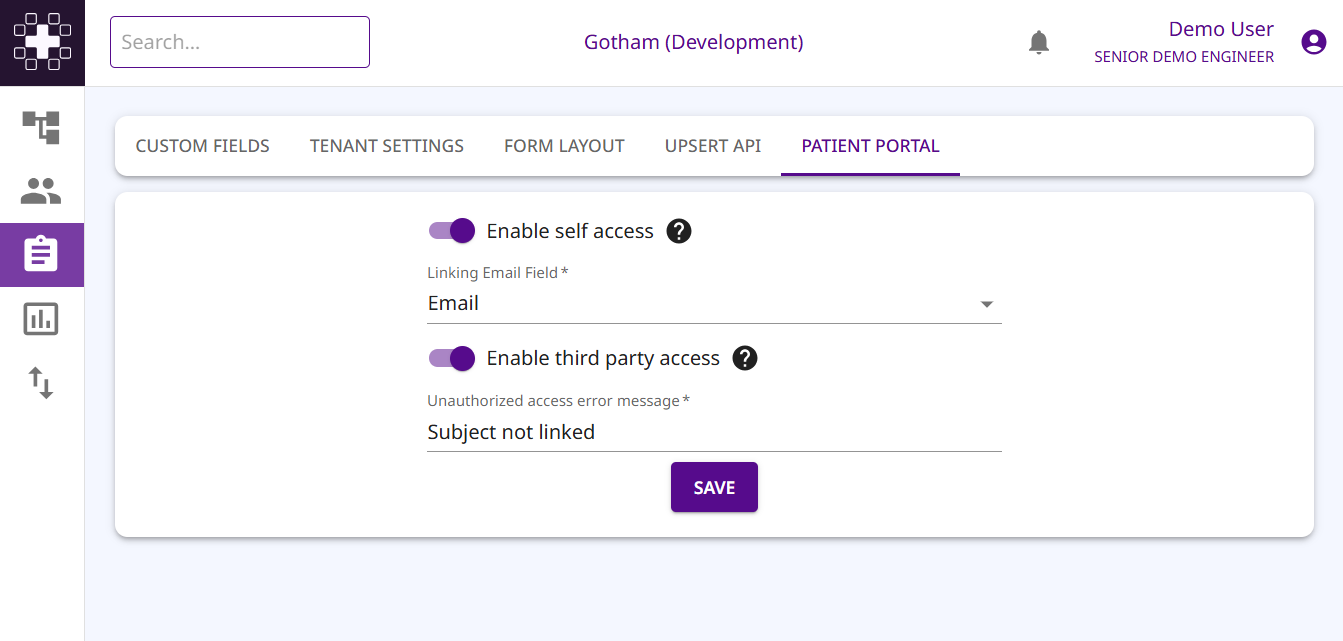Appearance
Subject Configuration
Subject configuration is where you configure all the settings related to subjects. This includes the subject provider, data fields, unsolicited inbound messaging and portal access.

Subject Provider
The subject provider is the data source that provides the subjects and the organisation structure data to AireFrame.
WARNING
Changes to the subject provider can have a significant impact on the data in AireFrame.
Contact support@airelogic.com if you are unsure about changing the subject provider.
The subject provider data source may only provide read-only functionality, this will be reflected in the AireFrame UI. For example, if a data source is read-only, the user will not be able to create or edit subjects.
Subject Avatar
The subject avatar is a visual representation (profile picture) associated with each subject.
When enabled, the avatar is visible on both the subject banner and in the multi-subject view.
Custom Fields
Subject custom fields are organised into three categories:
- Primary field - A single field that is shown at the top of the banner, even when minimised. This is also the field that is shown on the subject lists.
- Grouped fields - Each group is shown as an induvidual tab on the subject banner when expanded. Groups contain one or more fields. The groups and their fields are shown in the specified order.
- For example, you can group all the contact information fields together, and all the demographic information fields together.
- Which users can see which groups and fields can be controlled using resource restrictions
- Hidden fields - These are input fields that are not shown on the subject banner but still appear in subject forms.
- For example, you can capture information about a subject using several input fields; then use a computed field to join these together and hide the induvidual fields.
Field Types & Validation
There are two types of fields in AireFrame, Input Fields and Computed Fields.
Input Fields
Input fields are those that can be filled in by the user. All input fields have a specific data type, e.g. text or date.
All input fields can be set as:
- Required - The user must fill in the field before they can save the subject.
- Unique - Only one subject in the entire tenant can have a particular value (case and whitespace insensitive).
- Multiple Values - The user can add and remove values for this field.
INFO
Fields cannot be set as both unique and multiple values.
Input field keys are automatically generated from the initial field name and must be unique. Once the key is set, it cannot be changed.
INFO
Field validation is only run when the subject is saved, not when the configuration is updated.
For example, if you set a field as unique, it will only check for uniqueness when the subject is saved.
WARNING
Removing an input field can have side effects. This also includes removing and re-adding the field with the same key.
If you are using the internal data source, removing a field will remove the data for that field from all subjects. This is non-reversible.
Computed Fields
Computed fields are liquid expressions that allow you to combine or reformat the data from the input fields.
You can reference the input fields as variables in the liquid expression by using the key of the input field.
EXAMPLES
If i had two input fields with keys, firstName and lastName, I could create a computed field that combines them like this:
{{ firstName }} {{ lastName }}If i had a multiple values field with the key emails, I could create a computed field that joins all the emails together like this:
{{ emails | join: ', ' }}Specific HTML tags are allowed in computed fields. See the formatting guide for more information.
Form Layout
The order of the input fields can be changed on the subject form page by dragging and dropping the fields.
Naming
The naming of subjects and locations (structural entity assignments) can be controlled within the Tenant Settings tab.
API Upsert
AireFrame can be configured to allow messages from external systems to create/update subjects. View the API details here.
To use unsolicitied inbound messaging at least one field must be specified as a matching field. AireFrame will use these fields to determine if the subject already exists in the system; if they do the subject will be updated, otherwise a new subject will be created.
TIP
The matching field(s) must always be present on the inbound message.
If a subject exists, all other fields are optional and the provided fields will be updated on the subject.
If the subject does not exist, all required fields must be provided.
You must also specify the structural entity which new subjects will be assigned to.
Override Structural Entity Assignment Behaviour
It is possible to override the structural entities a subject is assigned to from an inbound subject message. This option defines the how AireFrame treats the structural entity keys that can be sent on the inbound subject message.
- Ignore
- This is the default option
- For a new subject, they will be added to the unmatched structural entity and the structural entity keys passed in on the message will be ignored
- For an existing subject, they will remain assigned to their existing structural entities and the structural entity keys passed in on the message will be ignored
- Add
- For a new subject, they will be added to the unmatched structural entity and any structural entities specified on the message
- For an existing subject, they will be added to the structural entities specified on the message while remaining assigned to their existing structural entities
- Replace
- For a new subject, they will only be added to the structural entities specified on the message
- For an existing subject, they will be removed from any existing structural entity assignmed and added to the structural entities specified on the message
- If no structural entity keys are specified on the message, the default (Ignore) behaviour will be followed
Subject Portal
AireFrame offers a portal for subjects and/or authorized third-parties to view their own data. This is a secure way for users to access their data without needing to contact the organisation.
INFO
A user must be invited to the portal before they can access it. See inviting users to the portal for a guide on how to do this.
TIP
A single user can be linked to multiple subjects. If a user is linked to multiple subjects, they will be able to switch between them in the portal.

To enable, you must first decide what type(s) of users you want to be able to access the portal.
Self-Access
Subjects are invited to the portal using the value of the configured email custom field, each subject can only be linked to one user.
To use self-access you must specify which email field you want to use to invite the subject.
INFO
Multiple value fields cannot be used as the email field for self-access.
Third-Party Access
Third-parties are invited to the portal using an email entered at the time of invitation, multiple users can be linked to the same subject.